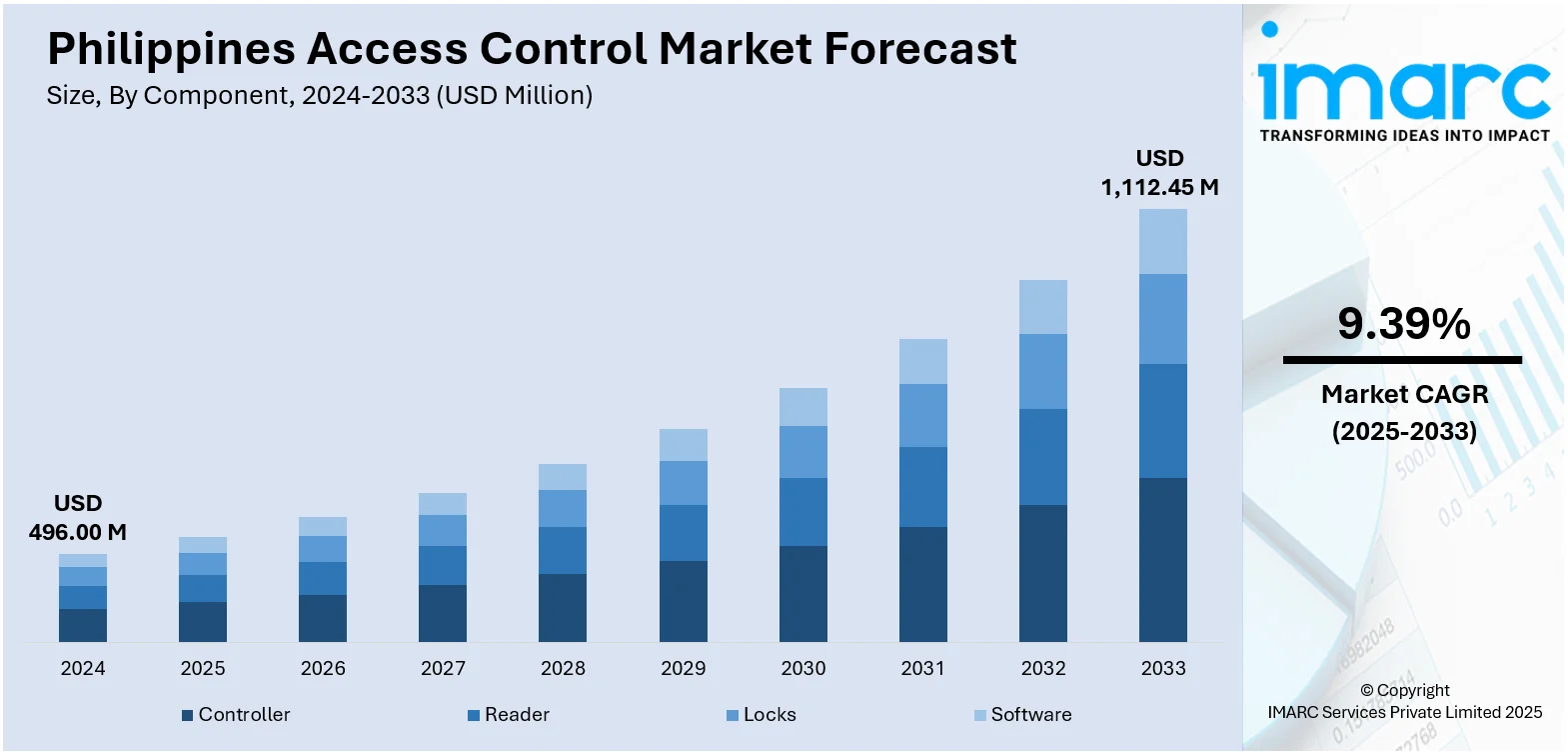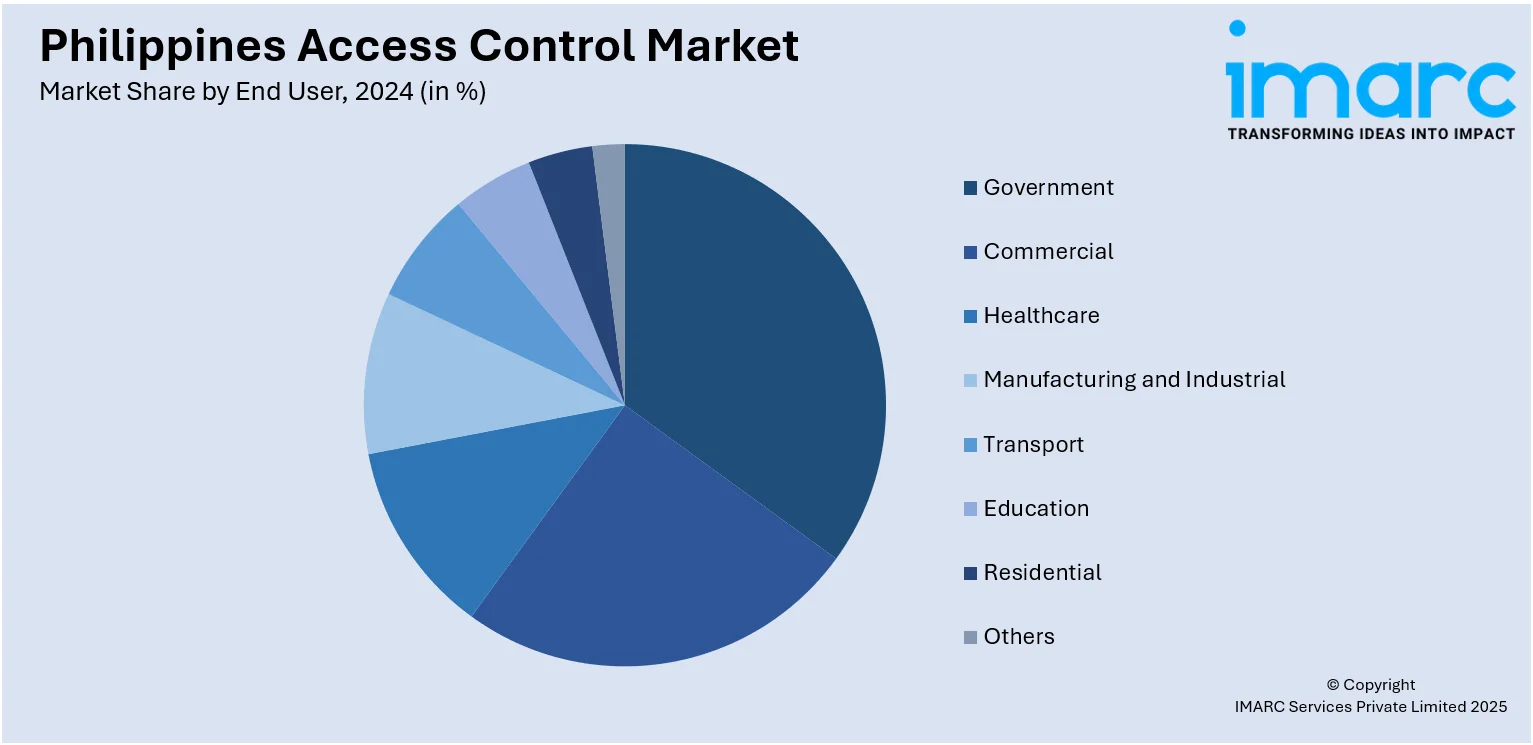
Philippines Access Control Market Size, Share, Trends and Forecast by Component, Type, End User, and Region, 2025-2033
Philippines Access Control Market Overview:
The Philippines access control market size reached USD 496.00 Million in 2024. The market is projected to reach USD 1,112.45 Million by 2033, exhibiting a growth rate (CAGR) of 9.39% during 2025-2033. The market is driven by the increasing security concerns in commercial, residential, and government sectors, alongside rapid urbanization and smart building developments. Adoption of advanced technologies like biometrics, radio frequency identification (RFID), and cloud-based systems is accelerating, driven by the need for efficient monitoring and regulatory compliance. Rising investments in infrastructure, growing awareness of workplace safety, and integration of Internet of Things (IoT) and artificial intelligence (AI) for real-time access management further fuel Philippines access control market share.
|
Report Attribute
|
Key Statistics
|
|---|---|
|
Base Year
|
2024
|
|
Forecast Years
|
2025-2033
|
|
Historical Years
|
2019-2024
|
| Market Size in 2024 | USD 496.00 Million |
| Market Forecast in 2033 | USD 1,112.45 Million |
| Market Growth Rate 2025-2033 | 9.39% |
Philippines Access Control Market Trends:
Rising Security Concerns Across Sectors
The growing requirement for robust security solutions is a major Philippines access control market trend. Urbanization, coupled with rising commercial, industrial, and residential construction, presents organizations with increased threats including theft, unauthorized entry, and cyber-physical invasions. Government offices, banks, hospitals, and business offices increasingly need sophisticated access control solutions to safeguard critical data, assets, and human resources. Also, high-profile security breaches in urban areas have increased awareness among business and resident communities, compelling them to embrace dependable solutions such as biometric readers, smart cards, and CCTV-integrated access systems. This trend is also underpinned by rules and regulatory obligations necessitating effective security measures. Broadly, the need for enhanced surveillance, controlled access, and real-time monitoring is a driving factor of investment and innovation in the Philippines access control market.

To get more information on this market, Request Sample
Infrastructure Development and Urbanization
Infrastructure growth and urbanization in the Philippines are fueling access control adoption, with rapid development of commercial complexes, residential condominiums, transport hubs, and government buildings creating strong demand for advanced security systems to safeguard assets and manage entry. Smart city initiatives and modernization projects further integrate access control into building management and public safety frameworks. Developers and property managers value these systems for enhancing operational efficiency, tracking personnel, and meeting safety regulations. This trend aligns with the country’s booming tourism sector, projected to contribute over ₱5.4 trillion (~US$100 billion) to the economy in 2024, representing 21.3% of GDP and employing nearly 9.5 million Filipinos. Growing investments in tourism, retail, and corporate sectors amplify the need for scalable, technologically advanced access solutions, directly linking urban expansion to the Philippines’ rising demand for sophisticated access control systems.
Technological Advancements and Integration
Technological advancement is impacting the access control industry in the Philippines to a large extent. Sophisticated systems today include biometric authentication, RFID, cloud management, AI-driven monitoring, and IoT integration, enabling real-time information and enhanced efficiency in operations. The technologies enable scalable, adaptable, and ease-of-use solutions appropriate for use in a range of settings, from small office buildings to big industrial complexes. Cloud-based access control allows centralized management, remote monitoring, and rapid updates, while AI analysis maximizes security by identifying abnormal patterns or threats. Furthermore, the shift toward contactless and mobile-enabled access, spurred by post-pandemic health issues, is fueling adoption in both public and private sectors. With technology evolving further, more organizations are happy to spend on intelligent, modern access solutions, fueling Philippines access control market growth.
Philippines Access Control Market Segmentation:
IMARC Group provides an analysis of the key trends in each segment of the market, along with forecasts at the country and regional levels for 2025-2033. Our report has categorized the market based on component, type, and end user.
Component Insights:
- Controller
- Reader
- Locks
- Software
The report has provided a detailed breakup and analysis of the market based on the component. This includes controller, reader, locks, and software.
Type Insights:
- Card Based
- Contact
- Contactless
- Biometric Based
- Fingerprint
- Face Recognition
- Face Recognition and Fingerprint
- Iris Recognition
- Others
A detailed breakup and analysis of the market based on the type have also been provided in the report. This includes card based (contact, contactless), and biometric based (fingerprint, face recognition, face recognition and fingerprint, iris recognition, and others).
End User Insights:

- Government
- Commercial
- Healthcare
- Manufacturing and Industrial
- Transport
- Education
- Residential
- Others
A detailed breakup and analysis of the market based on the end user have also been provided in the report. This includes government, commercial, healthcare, manufacturing and industrial, transport, education, residential, and others.
Regional Insights:
- Luzon
- Visayas
- Mindanao
The report has also provided a comprehensive analysis of all the major regional markets, which include Luzon, Visayas, and Mindanao.
Competitive Landscape:
The market research report has also provided a comprehensive analysis of the competitive landscape. Competitive analysis such as market structure, key player positioning, top winning strategies, competitive dashboard, and company evaluation quadrant has been covered in the report. Also, detailed profiles of all major companies have been provided.
Philippines Access Control Market News:
- In March 2025, The Philippines, in partnership with the UN, launched the Advanced Passenger Information System using UN GoTravel software to strengthen border security. The system aims to prevent transnational crime and terrorism by enhancing intelligence sharing, risk assessment, and travel document verification. Developed with the Department of Justice, Bureau of Immigration, Department of Foreign Affairs, Anti-Terrorism Council, and support from the UN and Australia, it enables proactive and swift national security responses.
- In July 2024, Equinix, a global digital infrastructure leader, is entering the Philippine market by acquiring three data centers from Total Information Management (TIM). Valued at about 15 times projected EBITDA, the deal is set to close in late 2024. The facilities, offering over 1,000 cabinets and future expansion capacity, will enhance secure interconnection services, support digital transformation, and tap into the Philippines’ fast-growing $35 billion digital economy by 2025.
Philippines Access Control Market Report Coverage:
| Report Features | Details |
|---|---|
| Base Year of the Analysis | 2024 |
| Historical Period | 2019-2024 |
| Forecast Period | 2025-2033 |
| Units | Million USD |
| Scope of the Report | Exploration of Historical Trends and Market Outlook, Industry Catalysts and Challenges, Segment-Wise Historical and Future Market Assessment:
|
| Components Covered | Controller, Reader, Locks, Software |
| Types Covered |
|
| End Users Covered | Government, Commercial, Healthcare, Manufacturing and Industrial, Transport, Education, Residential, Others |
| Regions Covered | Luzon, Visayas, Mindanao |
| Customization Scope | 10% Free Customization |
| Post-Sale Analyst Support | 10-12 Weeks |
| Delivery Format | PDF and Excel through Email (We can also provide the editable version of the report in PPT/Word format on special request) |
Key Questions Answered in This Report:
- How has the Philippines access control market performed so far and how will it perform in the coming years?
- What is the breakup of the Philippines access control market on the basis of component?
- What is the breakup of the Philippines access control market on the basis of type?
- What is the breakup of the Philippines access control market on the basis of end user?
- What is the breakup of the Philippines access control market on the basis of region?
- What are the various stages in the value chain of the Philippines access control market?
- What are the key driving factors and challenges in the Philippines access control market?
- What is the structure of the Philippines access control market and who are the key players?
- What is the degree of competition in the Philippines access control market?
Key Benefits for Stakeholders:
- IMARC’s industry report offers a comprehensive quantitative analysis of various market segments, historical and current market trends, market forecasts, and dynamics of the Philippines access control market from 2019-2033.
- The research report provides the latest information on the market drivers, challenges, and opportunities in the Philippines access control market.
- Porter's five forces analysis assist stakeholders in assessing the impact of new entrants, competitive rivalry, supplier power, buyer power, and the threat of substitution. It helps stakeholders to analyze the level of competition within the Philippines access control industry and its attractiveness.
- Competitive landscape allows stakeholders to understand their competitive environment and provides an insight into the current positions of key players in the market.
Need more help?
- Speak to our experienced analysts for insights on the current market scenarios.
- Include additional segments and countries to customize the report as per your requirement.
- Gain an unparalleled competitive advantage in your domain by understanding how to utilize the report and positively impacting your operations and revenue.
- For further assistance, please connect with our analysts.
 Request Customization
Request Customization
 Speak to an Analyst
Speak to an Analyst
 Request Brochure
Request Brochure
 Inquire Before Buying
Inquire Before Buying




.webp)




.webp)












